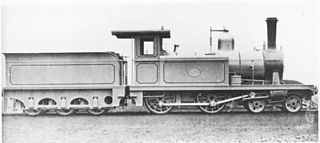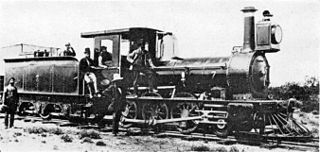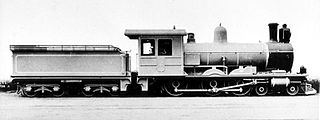
4-4-0, in the Whyte notation, denotes a steam locomotive with a wheel arrangement of four leading wheels on two axles, four powered and coupled driving wheels on two axles, and no trailing wheels.
Under the Whyte notation for the classification of steam locomotives by wheel arrangement, 2-4-0+0-4-2 is an articulated locomotive, usually of the Garratt type. The wheel arrangement is effectively two 2-4-0 locomotives operating back to back, with the boiler and cab suspended between the two power units. Each power unit has two leading wheels on one axle, four powered and coupled driving wheels on two axles and no trailing wheels. A similar wheel arrangement exists for Mallet locomotives, but is referred to as 2-4-4-2 since only the front engine unit can pivot.

The South African Railways Class 8X 2-8-0 of 1901 was a steam locomotive from the pre-Union era in the Cape of Good Hope.

The South African Railways Class 8D 4-8-0 of 1903 was a steam locomotive from the pre-Union era in the Cape of Good Hope.

The South African Railways Class 8F 4-8-0 of 1904 was a steam locomotive from the pre-Union era in the Cape of Good Hope.

The South African Railways Class 7A 4-8-0 of 1896 was a steam locomotive from the pre-Union era in the Cape of Good Hope.

The South African Railways Class 6B 4-6-0 of 1897 was a steam locomotive from the pre-Union era in the Cape of Good Hope.

The South African Railways Class 6H 4-6-0 of 1901 was a steam locomotive from the pre-Union era in the Cape of Good Hope.

The South African Railways Class 6J 4-6-0 of 1902 was a steam locomotive from the pre-Union era in the Cape of Good Hope.

The South African Railways Class 6K 4-6-0 of 1901 was a steam locomotive from the pre-Union era in the Cape of Good Hope.

The South African Railways Class 4 4-8-2 of 1911 was a steam locomotive from the pre-Union era in the Cape of Good Hope.
The CGR Class H1 was a 2-4-0+0-4-2T Garratt steam locomotive built by Beyer, Peacock & Company, England for the Ceylon Government Railway (CGR), now Sri Lanka Railways. Only one locomotive of this type was built, and its CGR plate number was 293.

The Cape Government Railways 1st Class 4-4-0TT of 1881 was a South African steam locomotive from the pre-Union era in the Cape of Good Hope.

The Cape Government Railways 1st Class 2-6-0 of 1876 by Beyer, Peacock and Avonside was a South African steam locomotive from the pre-Union era in the Cape of Good Hope.

The Cape Government Railways 4th Class 4-4-2 of 1897 was a South African steam locomotive from the pre-Union era in the Cape of Good Hope.

The Cape Government Railways 1st Class 2-6-0 of 1876 by Kitson was a South African steam locomotive from the pre-Union era in the Cape of Good Hope.

The South African type XD tender was a steam locomotive tender from the pre-Union era in the Cape of Good Hope.

The South African type XE1 tender was a steam locomotive tender from the pre-Union era in the Cape of Good Hope.

The South African type XC1 tender was a steam locomotive tender from the pre-Union era in the Cape of Good Hope.

The South African type XM tender was a steam locomotive tender.



















